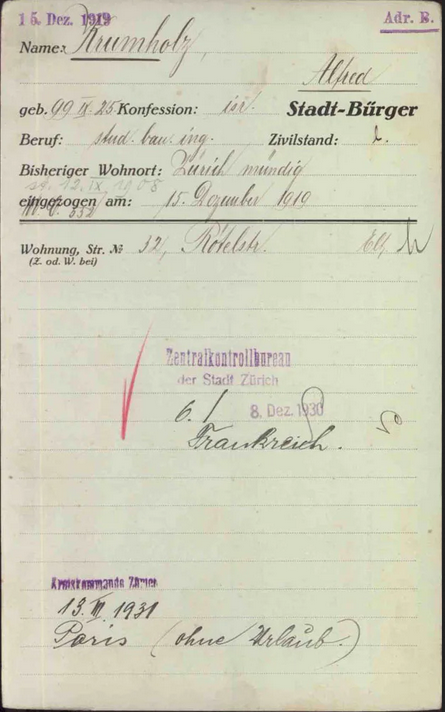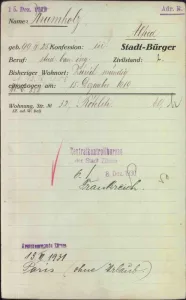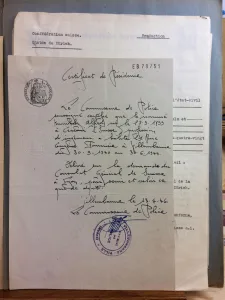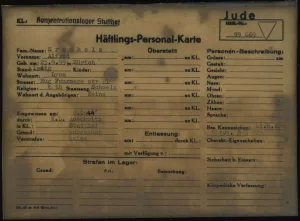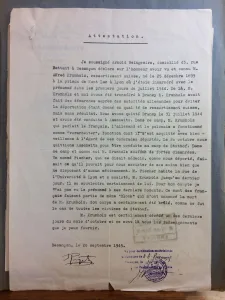Alfred KRUMHOLZ
Alfred Krumholz was born in 1899 in Jaroslaw, which is now in Poland but was then in the vast Austro-Hungarian Empire. Alfred had an older brother, Bronislaus Heinrich, and a younger sister, Helena.[1] In 1908,[2] the family moved to Switzerland. The father, Léon Krumholz, became manager of a textile store in Zurich. This was a branch of the “Wiener Kleiderhaus”, a chain of stores which, under the name of “Heilmann Kohn und Söhne” (in Polish: “Heilmann Kohn i synowie”), was active in many of the major cities of Central Europe, including Vienna, Budapest, Lviv, Krakow and Innsbruck.[3]
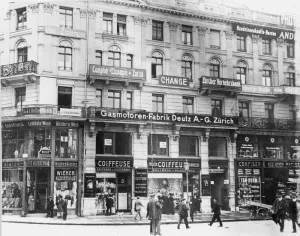
“Wiener Kleiderhaus”, Bahnhofplatz 3, Zurich, 1910. In the photo, the store is on the lower left. Source: E-Pics Baugeschichtliches Archiv (ethz.ch)
In 1909, the family moved to Rötelstrasse.[4] In 1915, in Zurich, the Krumholz family was granted Swiss citizenship by naturalization. The children went to various different schools.[6] After graduating from high school, the boys went to the Swiss Federal Institute of Technology in Zurich, while Helena studied law. In 1922, Heinrich[7] and Alfred[8] graduated from the Institute of Technology with degrees in building engineering.
Heinrich got a job as an engineer in France, where he took part in several major construction projects. Alfred continued to study engineering in Zurich until 1928[9]. After gaining experience in the Saarland, he moved to France, where, like his brother before him, he set up home. In 1930, he found a job as an engineer with the “Société des Grands Travaux de Marseille”, a major construction company.[10]
Information about Alfred Krumholz, Residents’ Registration list (“ Einwohnerkontrolle”) Zurich. Source: Zurich city archives, V.E.c.100.
He then went to live in the 17th district of Paris:
Paris Archives, Extract from the 1936 census, (ref. D2M8_663_0216, page 215). As mentioned on bottom left, Alfred Krumholz was listed as a “civil engineer” and lived at 133, Avenue de Wagram.
Unfortunately, we have so far been unable to locate the construction sites on which Alfred worked. However, thanks to the information that his brother later provided about his own career, we have a rough idea of the opportunities that France offered to the young Swiss engineer who graduated from the Swiss Federal Institute of Technology between the wars. Heinrich Bronislaus Krumholz’s career path was similar to Alfred’s: between 1924 and 1926, he was deputy director of a company that rebuilt the sugar works at Aulnoy-sur-Laon in the Aisne department of France. He then worked as consulting engineer for two senior architects in the French Naval Ministry, Hermant and André Maurice, and worked with the Balmain firm on the construction of the central section of the shipbuilding school in Brest, on the west coast of France.[11]
In around September 1940, when Paris was already an extremely dangerous place to be, Alfred fled to Lyon, in the Rhone department of France, which was in the unoccupied zone in the southern part of France. As of April 1, 1941, he worked for the Lyon branch of the “Société des Grands Travaux de Marseille”, which at that time was based at 6, rue Emila Zola in Lyon. Henri, meanwhile, returned permanently to Switzerland in August 1942, where he initially lived in Zurich, and then moved to Ticino.[12]. As for Alfred, he stayed in Villeurbanne, a district of Lyon, where he lived at 21, rue Eugène Fournière, even after the Germans occupied the free zone in November 1942.

21, Rue Eugène Fournière, Alfred Krumholz’s home in Villeurbanne
(Photo taken in February 2023).
According to a 1946 residence certificate, Alfred continued to live at this address until he was arrested:
According to this record, Alfred Krumholz lived at 21, Eugène Fournière from September 30, 1940 to June 30, 1944. Source: KRUMHOLZ-Alfred-DAVCC-21-P-470-730-10.jpg (1713×2284) (convoi77.org)
Throughout that period, he remained close to his family in Switzerland. When his parents died in 1940, within the space of a few months of each other (Leon died on May 14, 1940; Anna on July 28, 1940), he was unable to make the trip to attend the funerals. Later, however, he managed to visit his brother in Zurich several times. His last visit to Switzerland, which logged by the Geneva border authorities,[13] was from May 29 to 31, 1944.[14]
Just one month later, on June 30, 1944, Alfred Krumholz was arrested during a round-up at Place Bellecour in Lyon.[15] As soon as his brother and sister learned what was happening, they tried desperately to get Alfred released by making contact with Swiss representatives in Lyon, Vichy, Paris and Berlin. Elena Krumholz, Alfred’s sister, who lived in Ticino, even managed to alert a member of the Italian-speaking Swiss government, Enrico Celio, but to no avail. Despite all their efforts, Alfred remained in detention in Montluc jail in Lyon, where he was tortured.[16] On July 24, he was transferred to Drancy camp, north of Paris. From there, on July 31, he was deported to Auschwitz on Convoy 77. Then, towards the end of October 1944, Alfred Krumholz was transferred one last time, this time from Auschwitz to the Stutthof camp, where he died shortly afterwards as a result of the abuse and beatings he had suffered.[17]
Record card on Alfred Krumholz from the Stutthof camp.
His sister Helena (or Elena) died in 1970 and his brother Bronislaus Heinrich died in 1977.[18]
We have been unable to find any photos of Alfred Krumholz. However, he is mentioned in several survivors’ testimonies, including those of Raphael and Arnold Reingewirz and Moïse Karsenty.
Arnold Reingewirz’s witness statement, KRUMHOLZ-Alfred-DAVCC-21-P-470-730-13.jpg (1713×2284) (convoi77.org)
Notes et références
[1] Cf. Jewish Records Indexing (visité le 29 août 2018): Les parents Leon Leib Krumholz et Chaja Sura Gronner, résidant à Jaroslaw, Kamienica, avec les trois enfants Bronislaw Henryk (*1898), Alfred (*1899) et Helena (*1902). Pour l’histoire de la communauté juive de Jaroslaw, cf. Jerzy Czechowicz, Zarys historii Żydów w Jarosławiu i okolicy. Holokaust, czasy powojenne i współczesne, Rzeszów 2015.
[2] Archives de la ville de Zurich, Meldekarten der Einwohnerkontrolle Zürich (V.E.c.100).
[3] Annonce dans : Grütlianer [Journal suisse] du 16 mai 1908.
[4] Adresse zurichoise de la famille dans cette période : De 1909 à 1911 : 24, Rötelstrasse ; de 1912 à 1937 : 32, Rötelstrasse ; dès 1938: 338, Winterthurerstrasse. Source : Adressbuch der Stadt Zürich, conservé à la Bibliothèque Nationale Suisse, Berne.
[5] Archives d’Etat du Canton de Zurich (StAZH MM 3.29 RRB 1915/0363), 18 février 1915 (https://suche.staatsarchiv.djiktzh.ch/Dateien/158/D793365.pdf).
[6] On trouve Alfred dans les programmes annuels du « Realgymnasium » (StAZH III Ee 5/1). Son frère Henryk / Heinrich fréquentait par contre la « Industrieschule » zurichoise (StAZH III Ee 7/1), pour Helena c’était l’institut « Minerva » (cf. http://www.matrikel.uzh.ch/active/static/26677.htm ).
[7] Schweizerische Bauzeitung du 11 février 1922 (volume 79/6), p. 78.
[8] Schweizerische Bauzeitung du 19 août 1922 (volume 80/8), p. 94.
[9] Etudes de jurisprudence, 1924-1928. Source : Matrikel, Universität Zürich, Matrikeledition (uzh.ch).
[10] Dominique Barjot. La trace des bâtisseurs. Histoire du groupe Vinci, Rueil-Malmaison 2003, p. 259.
[11] Archives Fédérales Suisses, E2001-08#1978/107#968* Krumholz, Alfred, 1899; Krumholz, Henri, Montagnola b/Lugano.
[12] Adresse à Zurich : Winterthurstrasse 338.
[13] Pour la situation genevoise durant cette période, cf. Ruth Fivaz-Silbermann. La fuite en Suisse, Genève 2017.
[14] Archives d’Etat de Genève (AEG), Justice et police Ef2, dossier 5093.
[15] Pour Carlo Polla, cf. : Archives Fédérales Suisses (AFS), E2200.42-01#1000/594#544*.
[16] Plusieurs dossiers aux Archives Fédérales Suisses (AFS).
[17] Date officielle de mort: 31 octobre 1944, cf. AFS. Dossier Krumholz Alfred (E 2001-08#1978/107#968*.
[18] Date officielle de mort d’Helena (Elena) Rezzonico Rezzonico-Krumholz : 9 juin 1970 à Porza (source : Atto di morte Ufficio dello stato civile, Breganzona); date officielle de mort de Bronislaus Heinrich : Krumholz : 22 mars 1977 à Cevio (source : Feuille officielle suisse du commerce, p.3493)


 Français
Français Polski
Polski